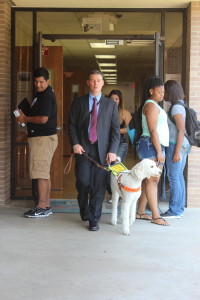Staff Writer
When people think of a Seeing Eye guide dog, most think about a Golden Retriever or even a German Shepherd. Rarely do people think of a poodle.
Well, that is the case for the Standard Poodle service dog that belongs to Northeast Texas Community College History Professor John Russo. But, despite the oddity of its breed, the animal helps Russo, who began losing his sight as a child and became completely blind in 1996, navigate his daily environment safely.
Russo’s new companion is the type of guide dog that never leaves its owner’s side. “I take him everywhere I go and if I don’t take him with me and I leave him lying in one spot, he’ll get up and come find me and lay at my feet,” Russo said.
It wasn’t an easy process for Russo to receive his service dog, although he said he has wanted one for some time. Just to be placed on a waiting list, a person has to fill out an application, be interviewed over the phone and provide three references from close friends. After doing all that, Russo still waited three years due to scheduling conflicts.
It takes 26 days to go through training with Pilot Dogs, a company that trains and provides service dogs. Company representatives observed Russo for three days, watching the way he interacted with his students, and observing the room they provided while he trained with his dog to see how organized and tidy he was in his everyday life.
Russo was given a strict schedule to follow to see how well he kept a routine and to gauge his punctuality. They also took his personality, schedule and temperament into account when matching him with his dog. A poodle was chosen because the breed is hypoallergenic and will not cause allergies for any students or Russo. Every consideration was given in matching this particular dog to its new life and best friend.
Just like an awkward first date, Russo was nervous meeting his dog for the first time. “I was excited to meet my dog, but they said dogs pay close attention to body language and because you’re a stranger that excitement can actually cause the dog stress,” Russo explained. “So they said the best thing to do was to stay calm, stay quiet and no sudden movements. I took it to the extreme; I stood still as a board. He walked up to me and didn’t get a reaction, so he licked my face like “hello” and then laid down at my feet. After that I called his name and started petting him.”
There is an incredible amount of time, love, work and dedication that goes into training a guide dog.
According to the Pilot Dogs website, the company is supported entirely by public contributions. This nonprofit company trains dogs only if they are raised in a home, accustomed to playing with children, meeting strangers and have the opportunity to be near traffic. It takes a very special canine to become a Seeing Eye dog.
The person receiving the service animal gets just as much training as the dog. People who receive their first guide dog are required to live on site for about a month for familiarity and training sessions. Their training month ends with a graduation walk, which includes leaving the building, going to a bus stop, taking a bus downtown, following a prescribed route with many different kinds of crossings and buying something in a store.
Russo was committed to creating a bond with the animal and worked alongside his service dog to receive his diploma. He said that the hardest thing for him at first was learning to trust that his dog wouldn’t run him into things. But, by graduation the two were working as a team.
Since returning from training and having the dog at home, Russo said he’s developed a connection to the animal like he’s never had before. “I have pet dogs and I will pet them sometimes and go about my business, but having the guide dog with me all the time and knowing he is looking out for me, makes him more than just a pet,” he said. “It’s definitely a relationship I didn’t know I would develop. I can truly say I love the dog.”
Having a guide dog around campus is somewhat of a novelty. Russo said though most of his students don’t seem to pay much attention to the animal. Ryan Johnson, a student in one of Russo’s history classes, said, “It’s definitely interesting. No other teacher on campus has a dog and during class he doesn’t cause a distraction. He just sits under the desk. It’s almost like he’s not even there.”
The campus community has been asked to respect Russo and his dog’s boundaries and follow the proper guide dog etiquette. It has been requested that students and faculty do not greet the dog, pet the dog or even look the dog in the eye. Doing so could cause a distraction and might endanger both the animal and its owner. The dog should be ignored so he can focus all his attention on navigating for his owner. And, just in case anyone gets distracted by this amazing animal a sign on the front of his vest saying, “Ignore me” reminds them. Even the dog’s name is kept secret in order to keep people from calling out to the animal.
As Russo and his new companion settle into their routine, before long this twosome, which add to the diversity of the campus, will soon become the history professor who just happens to have a dog in his classroom.
